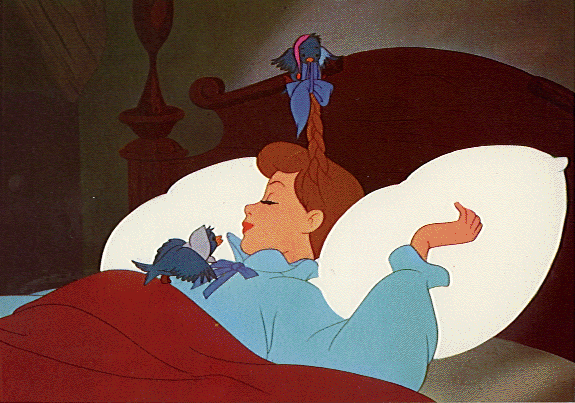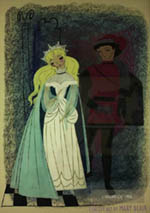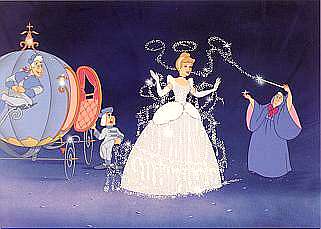

Directed by: Clyde Geronimi & Wilfred Jackson
Written by: Ken Anderson (I) & Homer Brightman
Music by: Jerry Livingston, Mack David & Al Hoffman
Released on: February 15, 1950
Running Time: 74 minutes
Box-Office: $41 million in the U.S. (plus $21.305m during its
1981 re-issue), $315 million worldwide (adjusted to current dollars)
 Cinderella...
Ilene Woods
Cinderella...
Ilene Woods
Lady Tremaine... Eleanor Audley
Fairy Godmother... Verna Felton
Drizella... Rhoda Williams
![]()
![]() Eleanor Audley (1905-1991), the voice of the Wicked Stepmother in Cinderella,
is also the voice of Madam Leota in the Haunted Mansion at Disneyland
and Disneyworld, and Maleficent in Sleeping
Beauty.
Eleanor Audley (1905-1991), the voice of the Wicked Stepmother in Cinderella,
is also the voice of Madam Leota in the Haunted Mansion at Disneyland
and Disneyworld, and Maleficent in Sleeping
Beauty.
![]() Verna Felton (1890-1966), the voice of the Fairy Godmother, started and
finished her career at Disney as an elephant -no pun intended!-: first
in Dumbo (1941), then in The Jungle Book (1967). Funny
to notice she was also the evil Queen of Hearts in Alice in Wonderland
(1951), Aunt Sarah in Lady and the Tramp (1955) and Flora in Sleeping
Beauty (1959).
Verna Felton (1890-1966), the voice of the Fairy Godmother, started and
finished her career at Disney as an elephant -no pun intended!-: first
in Dumbo (1941), then in The Jungle Book (1967). Funny
to notice she was also the evil Queen of Hearts in Alice in Wonderland
(1951), Aunt Sarah in Lady and the Tramp (1955) and Flora in Sleeping
Beauty (1959).
![]() Rhoda Williams, a radio veteran who was the voice of Drizella the stepsister,
also provided the live-action modeling for that character. Lesser
known is that she was the voice of the mother and the daughter, as well
as the model for both, in the Carousel of Progress attraction for the 1964
World's Fair -and later Disneyland.
Rhoda Williams, a radio veteran who was the voice of Drizella the stepsister,
also provided the live-action modeling for that character. Lesser
known is that she was the voice of the mother and the daughter, as well
as the model for both, in the Carousel of Progress attraction for the 1964
World's Fair -and later Disneyland.
![]() In 1946, three
classics had been in development for several years -Peter
Pan, Alice in Wonderland
and Cinderella. Walt Disney did not feel comfortable with either
Peter
Pan or Alice in Wonderland, finding the characters too cold.
Cinderella, on the other hand, possessed the qualities of Snow
White and the Seven Dwarfs, which is why he chose to go ahead with
this project.
In 1946, three
classics had been in development for several years -Peter
Pan, Alice in Wonderland
and Cinderella. Walt Disney did not feel comfortable with either
Peter
Pan or Alice in Wonderland, finding the characters too cold.
Cinderella, on the other hand, possessed the qualities of Snow
White and the Seven Dwarfs, which is why he chose to go ahead with
this project.
![]() Lucifer, the spoiled
housecat, presented a problem to animators. None of the character renderings
pleased Walt Disney. Then one day, as he was visiting Kimball's steam train
at his San Gabriel home, he saw the Kimball's housecat, a round, furry
calico, and he exclaimed "Hey -there's your model for Lucifer!".
Lucifer, the spoiled
housecat, presented a problem to animators. None of the character renderings
pleased Walt Disney. Then one day, as he was visiting Kimball's steam train
at his San Gabriel home, he saw the Kimball's housecat, a round, furry
calico, and he exclaimed "Hey -there's your model for Lucifer!".

![]() In Charles Perrault's 300-year-old French fable Cinderella was adapted
from, the heroine lost a fur slipper, not a glass one!
In Charles Perrault's 300-year-old French fable Cinderella was adapted
from, the heroine lost a fur slipper, not a glass one!
![]() This animated
feature was shot entirely in live action before the animation began!
This animated
feature was shot entirely in live action before the animation began!
![]() Several storyboard
sequences did not make the final cut, including "The Music Lesson", the
complete "Cinderella Work Song" and "Dancing on a Cloud".
Several storyboard
sequences did not make the final cut, including "The Music Lesson", the
complete "Cinderella Work Song" and "Dancing on a Cloud".
![]() An impressive
number of songs were written but not used in the final version of Cinderella,
including "Cinderella", "I'm In The middle of a Muddle", "I Lost My Heart
at the Ball", "The Mouse Song", "Sing a Little, Dream a Little", "Dancing
on a Cloud", "The Dress My Mother Wore", and "The Face That I See
In The Night".
An impressive
number of songs were written but not used in the final version of Cinderella,
including "Cinderella", "I'm In The middle of a Muddle", "I Lost My Heart
at the Ball", "The Mouse Song", "Sing a Little, Dream a Little", "Dancing
on a Cloud", "The Dress My Mother Wore", and "The Face That I See
In The Night".
![]() Storyman Bill
Peet recalled in the late '90s that "another crisis was Cinderella.
We were down to the point where we needed another Snow White, another
success. Walt loved to tell me this story. Walt and Roy had been arguing
for weeks. Roy told him that they couldn't afford to gamble everything
they had on one film. If they would sell out now, they could live comfortably
for the rest of their lives. Roy wanted to pick up the marbles and go home.
Walt insisted they do just one more, and he chose Cinderella. Without
that there would have been no Disneyland, no Epcot Center and no Disney
Studio today."
Storyman Bill
Peet recalled in the late '90s that "another crisis was Cinderella.
We were down to the point where we needed another Snow White, another
success. Walt loved to tell me this story. Walt and Roy had been arguing
for weeks. Roy told him that they couldn't afford to gamble everything
they had on one film. If they would sell out now, they could live comfortably
for the rest of their lives. Roy wanted to pick up the marbles and go home.
Walt insisted they do just one more, and he chose Cinderella. Without
that there would have been no Disneyland, no Epcot Center and no Disney
Studio today."
![]() In both Cinderella
(1950) and Sleeping Beauty (1959),
the main character's friends surprise her with a new dress, calling out
"Surprise! Surprise! Surprise! Happy birthday!"
In both Cinderella
(1950) and Sleeping Beauty (1959),
the main character's friends surprise her with a new dress, calling out
"Surprise! Surprise! Surprise! Happy birthday!"

![]() Cinderella marked the beginning of Disney's 2nd Golden Age, that would
end in 1967 with Walt's death. The 3rd Golden Age started in 1989
with The Little Mermaid.
Cinderella marked the beginning of Disney's 2nd Golden Age, that would
end in 1967 with Walt's death. The 3rd Golden Age started in 1989
with The Little Mermaid.
![]() The movie was
Oscar-nominated for Best Score, Best Song ("Bibbidy-Bobbidi-Boo") and Best
Sound.
The movie was
Oscar-nominated for Best Score, Best Song ("Bibbidy-Bobbidi-Boo") and Best
Sound.
![]() Cinderella
was the top grossing film of 1950 in the U.S., as it took in $41,087,000
that year.
Cinderella
was the top grossing film of 1950 in the U.S., as it took in $41,087,000
that year.
![]() Since 1950, Cinderella
has been released to theaters six times and has been seen by 75 million
people, grossing more than $315 million (adjusted to current dollars).
Since 1950, Cinderella
has been released to theaters six times and has been seen by 75 million
people, grossing more than $315 million (adjusted to current dollars).
THE ORIGINS OF THE CINDERELLA TALE
 There
are more than 3,000 versions of the Cinderella myth. Almost every world
culture has one -she's known as "Yeh Shen" in China, "The Burnt Face Girl"
to the Mik'maq tribe, "Tattercoats" in England, and "Marouckla" to the
Slavs. While the story can't claim a sole author, it does have a few notable
interpreters.
There
are more than 3,000 versions of the Cinderella myth. Almost every world
culture has one -she's known as "Yeh Shen" in China, "The Burnt Face Girl"
to the Mik'maq tribe, "Tattercoats" in England, and "Marouckla" to the
Slavs. While the story can't claim a sole author, it does have a few notable
interpreters.
Charles Perrault was a minor literary figure in 18th Century France. In 1697 he published Contes de la Mère l'Oie (Tales of Mother Goose), which refashioned several well-known folktales such as "The Sleeping Beauty," "Little Red Riding Hood," and "Cinderella."
Perrault cleaned up the popular peasant version of the Cinderella tale
for a more refined, upscale audience. In the original, the glass slipper
was filled with blood from the severed toes and bunions of the wicked stepsisters
[read more below], and the king eventually sentenced the step-mother and
daughters to dance themselves to death, wearing rot hot iron boots (a popular
form of torture in the Middle Ages). Originally, Cinderella had on
shoes made of fur, but this was changed to glass even before Charles Perrault
wrote his version of the story by a simple happy mistake: the french words
for "glass" ("verre") and "fur" ("vair") are very similar.

Mother Goose was translated into English in 1729, and the Brothers
Grimm produced their famous German version in 1812.
There is no fairy godmother in the Grimms': Cinderella's real mother
also dies here, and Cinderella plants a tree on her grave. The mother's
spirit inhabits this tree, and fulfills the function of the fairy godmother
by providing the garments for the ball. The mother's spirit is arguably
also contained in two white pigeons that assist Cinderella with her chores,
a fact picked up in the Disney movie with the helpful mice (mentioned in
Perrault as the horses for the coach) and birds that assemble her dress
and otherwise cheer up her dreary existence.

When it comes time for the ball in the Grimms' version, there is not
one, not two, but three full nights of dancing. Each time, Cinderella gets
her dress and shoes by appealing to her mother's tree, returning them back
after each night to change to her ash- covered clothing. Significantly,
there is no midnight deadline for her return -- if you read the Grimms
carefully, you see that Cinderella chooses to go home around midnight.
This is the same logic we saw in Perrault; she is leading this prince on,
because she wants him to fall in love with her and discover her at home,
where he will be forced to accept her as she really is.
The prince, suitably worked up just as she wanted him, decides to get crafty. He orders the staircase to be covered with pitch, so that she should become stuck in it if she flees once more at midnight. On the third night, she does flee, and her golden slipper becomes entangled and she is forced to leave it behind. He then canvasses the countryside searching for the one who fits the shoe -- a detail that Disney leaves out in favor of the Perrault version.
And so the prince arrives at Cinderella's house, where the sisters try
in vain to get the slipper to fit. Here the story veers radically away
from Perrault's retelling, for the Grimms insert some violence here to
punish the wicked sisters. The stepmother, in her zeal to secure the rich
and powerful prince as a son, instructs her daughters to cut off parts
of their feet to get the slipper to fit. Thus, the prince rides off with
one who has a bloody heel, returns when the pigeons warn him, and then
rides off with the other minus her big toe, until the birds again warn
him.
|
||||||||||||